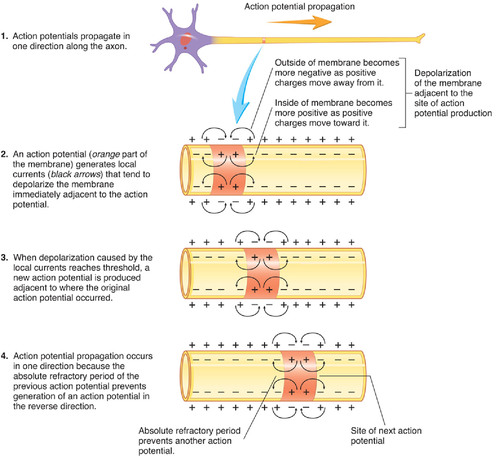Chapter 11: Functional Organization of Nervous Tissue
0.0(0)
Card Sorting
1/122
Study Analytics
Name | Mastery | Learn | Test | Matching | Spaced |
|---|
No study sessions yet.
123 Terms
1
New cards
5 functions of the nervous system (Smart Ions Hear Melodious Covers)
A. Sensory input - Monitor internal/external stimuli
B. Integration - Brain and spinal cord process sensory input and initiate responses.
C. Homeostasis - Regulate and coordinate physiology.
D. Mental activity - Consciousness, thinking, memory, emotion.
E. Control - Muscles and glands.
B. Integration - Brain and spinal cord process sensory input and initiate responses.
C. Homeostasis - Regulate and coordinate physiology.
D. Mental activity - Consciousness, thinking, memory, emotion.
E. Control - Muscles and glands.
2
New cards
Components of the nervous system (4 things)
1. Brain
2. Spinal cord
3. Nerves
4. Sensory receptors
2. Spinal cord
3. Nerves
4. Sensory receptors
3
New cards
Central NS (CNS) components
brain and spinal cord
4
New cards
Peripheral NS (PNS) components
sensory receptors and nerves
5
New cards
Sensory receptors
endings of neurons/specialized cells that detect: temperature, pain, touch, pressure, light, sound, and odors
6
New cards
Where are sensory receptors found?
skin, muscles, organs, etc.
7
New cards
Nerve
a bundle of axons + sheaths that connects CNS to sensory receptors, muscles, and glands
8
New cards
Cranial nerves
originate from the brain; 12 pairs
9
New cards
Spinal nerves
originate from spinal cord; 31 pairs
10
New cards
Ganglion
neuron cell bodies outside CNS
11
New cards
Plexus
Axons (and sometimes cell bodies) outside CNS
12
New cards
How many pairs of cranial and spinal nerves are in the nervous system?
A. 13,12
B. 12, 31
C. 31,13
D. 12, 21
A. 13,12
B. 12, 31
C. 31,13
D. 12, 21
B. 12, 31
13
New cards
Nerves connect to all the following structures except?
A. Nerves
B. Muscles
C. Glands
D. Cartilage
A. Nerves
B. Muscles
C. Glands
D. Cartilage
D. Cartilage
14
New cards
2 divisions of the PNS
A. Sensory (afferent): transmits action potentials from receptors to CNS.
B. Motor (efferent): transmits action potentials from CNS to effectors (muscles, glands)
B. Motor (efferent): transmits action potentials from CNS to effectors (muscles, glands)

15
New cards
2 sections of the motor division of the PNS
1. Somatic NS
2. Autonomic NS
2. Autonomic NS
16
New cards
Somatic NS (SNS) characteristics (4 things)
- carries action potentials from CNS to skeletal muscles
- is voluntarily controlled
- single neuron system
- cell bodies located within the CNS
- is voluntarily controlled
- single neuron system
- cell bodies located within the CNS
17
New cards
Autonomic NS (ANS) characteristics (3 things)
- carries action potentials from CNS to smooth and cardiac muscle & glands
- is involuntarily controlled
- two neuron system (CNS to ganglion, and ganglion to effector)
- 3 divisions: sympathetic, parasympathetic, enteric
- is involuntarily controlled
- two neuron system (CNS to ganglion, and ganglion to effector)
- 3 divisions: sympathetic, parasympathetic, enteric
18
New cards
Sympathetic division of ANS
most active during physical activity (fight or flight)
19
New cards
Parasympathetic division of ANS
regulates resting functions such as digesting food & emptying the bladder
20
New cards
Enteric division of ANS
plexuses in wall of digestive tract (reflex)
21
New cards
Order of the nervous system
Receptor -> Sensory NS -> CNS -> Motor NS -> Effector
22
New cards
2 types of cells in the nervous system
1. Neurons (nerve cells)
2. Neuroglia (glial cells)
2. Neuroglia (glial cells)
23
New cards
Neurons
receive stimuli and transmit action potentials
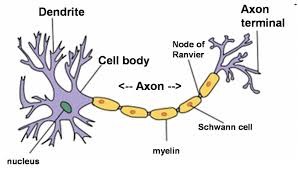
24
New cards
Organization of neurons
- Dendrites: input
- Cell body or soma
- Axons: output
- Cell body or soma
- Axons: output
25
New cards
Parts of a neuron (3 things)
A. Cell body (includes the nucleus & Nissl bodies)
B. Dendrites (include dendritic spines)
C. Axons (include axon hillock, initial segment, trigger zone, axoplasm, axolemma, presynaptic terminals/terminal boutons, & synaptic vesicles)
B. Dendrites (include dendritic spines)
C. Axons (include axon hillock, initial segment, trigger zone, axoplasm, axolemma, presynaptic terminals/terminal boutons, & synaptic vesicles)
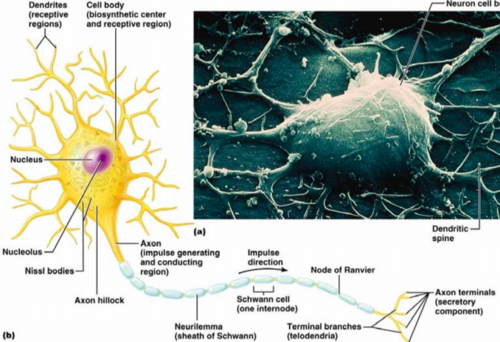
26
New cards
Nissl bodies
chromatophilic substances like the rough ER that are the primary site of protein synthesis
27
New cards
Dendritic spine
little protuberances where axons synapse with the dendrite
28
New cards
Axon hillock
single axon arises
29
New cards
Initial segment
beginning of axon
30
New cards
Trigger zone
site where action potentials are generated (made up of the axon hillock and initial segment)
31
New cards
Axoplasm
the cytoplasm of the axon
32
New cards
Axolemma
the axon's plasma membrane
33
New cards
Neuroglia
support and protect neurons
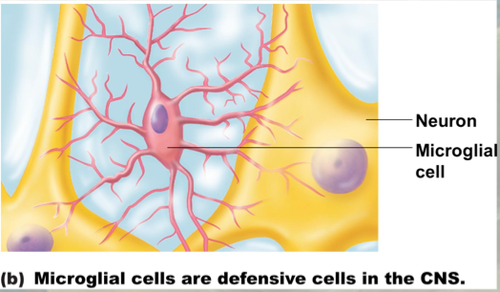
34
New cards
2 axonic transport mechanisms
A. Away from cell body (anterograde): can move proteins, organelles, and vesicles (Supplies for growth, repair, renewal) away from the cell body to the presynaptic terminal
B. Into cell body (retrograde): Damaged organelles, recycled plasma membrane, and substances taken in by endocytosis can be transported up the axon to the cell body (Rabies and herpes virus into CNS)
B. Into cell body (retrograde): Damaged organelles, recycled plasma membrane, and substances taken in by endocytosis can be transported up the axon to the cell body (Rabies and herpes virus into CNS)
35
New cards
Classification types of neurons
functional and structural
36
New cards
Functional classification of neurons
1. Sensory (afferent): action potentials toward CNS
2. Motor (efferent): action potentials away from CNS
3. Interneurons (association neurons): action potentials from neuron to neuron in CNS
2. Motor (efferent): action potentials away from CNS
3. Interneurons (association neurons): action potentials from neuron to neuron in CNS
37
New cards
Structural classification of neurons
1. Multipolar: many dendrites with a single axon, usually motor neurons (Ex: most neurons in CNS)
2. Bipolar: one dendrite one axon, usually sensory neurons (Ex: retina of the eye and nose)
3. Pseudo-unipolar: a single process that divides into two branches, usually sensory neurons
2. Bipolar: one dendrite one axon, usually sensory neurons (Ex: retina of the eye and nose)
3. Pseudo-unipolar: a single process that divides into two branches, usually sensory neurons

38
New cards
Which statement is totally true?
A. Sensory neurons are afferent neurons - conduct toward the CNS
B. Motor neurons are afferent neurons - conduct away from the CNS
C. Sensory neurons are efferent neurons - conduct toward the CNS
D. Motor neurons are efferent neurons - conduct toward the CNS
A. Sensory neurons are afferent neurons - conduct toward the CNS
B. Motor neurons are afferent neurons - conduct away from the CNS
C. Sensory neurons are efferent neurons - conduct toward the CNS
D. Motor neurons are efferent neurons - conduct toward the CNS
A. Sensory neurons are afferent neurons - conduct toward the CNS
39
New cards
Neuroglia of CNS
A. Astrocytes
B. Ependymal cells
C. Microglia
D. Oligodendrocytes
B. Ependymal cells
C. Microglia
D. Oligodendrocytes
40
New cards
Astrocytes characteristics (3 things)
1. Processes form feet that cover surface of neurons & blood vessels
2. Promote formation of the blood-brain barrier
3. Have an extensive cytoskeleton of microfilaments for support of blood vessels and nerves
2. Promote formation of the blood-brain barrier
3. Have an extensive cytoskeleton of microfilaments for support of blood vessels and nerves
41
New cards
5 functions of the astrocyte blood-brain barrier
1. Determines what substances can pass from the blood into the nervous tissue of the brain and spinal cord
2. Protects neurons from toxic substances
3. Allows exchange of nutrients and waste products between neurons and blood
4. Prevents fluctuations in blood composition from affecting the brain
5. Regulates extracellular brain fluid composition
2. Protects neurons from toxic substances
3. Allows exchange of nutrients and waste products between neurons and blood
4. Prevents fluctuations in blood composition from affecting the brain
5. Regulates extracellular brain fluid composition
42
New cards
Ependymal cells characteristics (3 things)
1. Line brain ventricles & spinal cord central canal
2. With blood vessels & support tissues they form Choroid plexuses in ventricles that secrete cerebrospinal fluid (CSF)
3. Cilia help move cerebral fluid through cavities of brain
2. With blood vessels & support tissues they form Choroid plexuses in ventricles that secrete cerebrospinal fluid (CSF)
3. Cilia help move cerebral fluid through cavities of brain
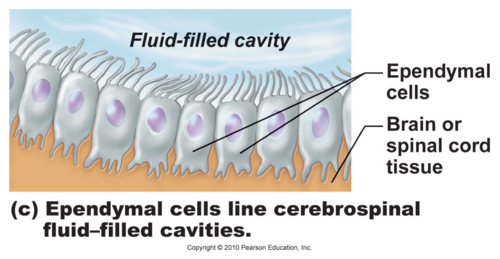
43
New cards
Microglia
become mobile & phagocytic in response to inflammation (they seek out and phagocytize necrotic tissue, microorganisms, and foreign substances that invade the CNS)
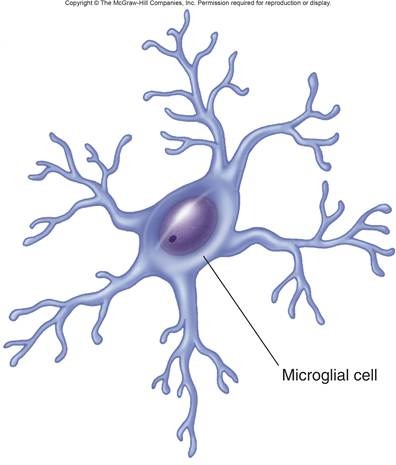
44
New cards
What evidence of damage in an autopsy can microglia show?
In the event of infection, trauma, or stroke numerous microglia migrate to the damaged area
45
New cards
Oligodendrocytes characteristics (2 things)
1. Form myelin sheaths if they surround an axon many times
2. Single oligodendrocytes can form myelin sheaths around portions of several axons.
2. Single oligodendrocytes can form myelin sheaths around portions of several axons.
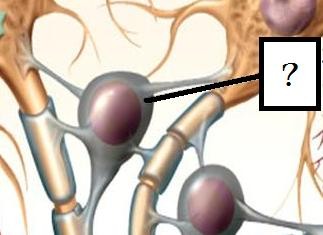
46
New cards
Neuroglia of PNS
A. Schwann cells/neurolemmocytes
B. Satellite cells
B. Satellite cells
47
New cards
Schwann cells/neurolemmocytes
wrap many times around a portion of only one axon - forms myelin sheath
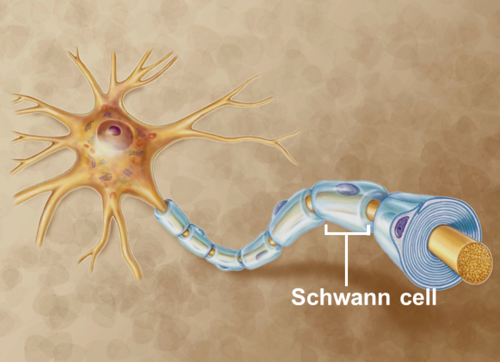
48
New cards
Satellite cells
1. Surround neuron cell bodies in sensory ganglia, providing support and nutrients to the neuron cell bodies (similar to astrocytes in the CNS)
2. Protect neurons from heavy metal poisons such as lead and mercury by absorbing them and reducing their access to the neuron cell bodies
2. Protect neurons from heavy metal poisons such as lead and mercury by absorbing them and reducing their access to the neuron cell bodies
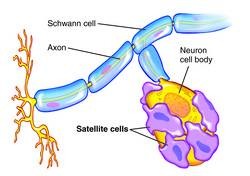
49
New cards
Remember:
Oligodendrocytes in the CNS also wrap around axons to form myelinated or unmyelinated axons.
50
New cards
Myelinated vs unmyelinated axons
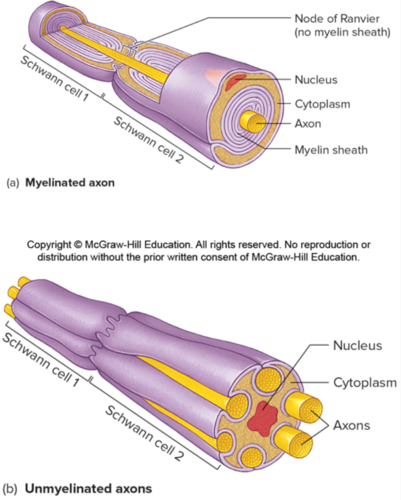
51
New cards
4 characteristics of myelinated axons
- protect & insulate axons from one another
- speed up transmission of action potentials
- make up "white" matter (lipids)
- have Nodes of Ranvier
- speed up transmission of action potentials
- make up "white" matter (lipids)
- have Nodes of Ranvier

52
New cards
Myelin sheaths up to 1 year old form ________ (rapidly or slowly?)
rapidly
53
New cards
Degeneration of myelin sheaths leads to:
multiple sclerosis
54
New cards
2 characteristics of unmyelinated axons
- Schwann Cell is not wrapped around the axon
- make up "gray" matter
- make up "gray" matter
55
New cards
White vs Gray Matter
In both the CNS & PNS nervous tissue is organized so that axons form bundles (white) while neuron cell bodies and their dendrites (gray) are grouped together.
56
New cards
T or F: Both the CNS & PNS contain areas of gray matter and white matter.
True
57
New cards
Gray matter
groups of neuron cell bodies and their dendrites with very little myelin
58
New cards
White matter
bundles of parallel myelinated axons
59
New cards
In the CNS, gray matter on the surface of the brain is called _________ & deeper clusters in the brain are called _________.
the cortex; nuclei
60
New cards
In the PNS, a cluster of neuron cell bodies is called _________.
a ganglion
61
New cards
White matter of the CNS forms nerve tracts that
propagate action potentials from one area of the CNS to another
62
New cards
In the PNS bundles of axons and their connective tissue sheaths are called _________.
a nerve
63
New cards
Choose the pair of terms that does NOT go together
A. Autonomic, voluntary
B. Somatic, voluntary
C. Autonomic, involuntary
D. Somatic, skeletal muscles
A. Autonomic, voluntary
B. Somatic, voluntary
C. Autonomic, involuntary
D. Somatic, skeletal muscles
A. Autonomic, voluntary
64
New cards
Electrical properties result from: (2 things)
1. Ion concentration differences across plasma membrane (inside and outside)
2. Permeability of membrane to ions
2. Permeability of membrane to ions
65
New cards
Ion concentration of cell at resting potential
High Na+ & Cl- outside cell, high K+ & negative proteins inside cell (like a potato chip)
66
New cards
What does the sodium-potassium pump do?
Maintains the difference of Na+ and K+ by breaking down 1 ATP (into ADP) to move 3 Na+ out and 2 K+ in
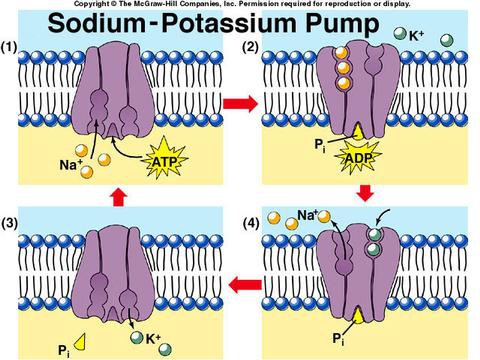
67
New cards
Explanation of membrane permeability
A. Proteins (which have a negative charge) are made inside cell and can't cross the membrane
B. Cl- is repelled by proteins so they exit through non-gated Cl- channels.
B. Cl- is repelled by proteins so they exit through non-gated Cl- channels.
68
New cards
Non-gated (Leakage) channels
channels that are always open, so they are responsible for membrane permeability to ions when the p.m. is unstimulated or at rest
69
New cards
There are many more leakage channels for ______ than for ______.
K+ & Cl-; Na+
70
New cards
At rest, more ______ are moving than ______.
K+ & Cl-; Na+
71
New cards
K+ is higher in concentration on the _______ than the _______, so it moves ________.
inside; outside, out
72
New cards
Because of the ion concentration differences across the membrane, K+ diffuses _______, and Na+ diffuses _______.
out of the cell, down its concentration gradient; into the cell, down its concentration gradient
73
New cards
Leak channels (non-gated):
A. Open in response to small voltage changes.
B. Open when a chemical signal binds to its receptor.
C. Allow substances to move into the cell but not out.
D. Are responsible for Resting Membrane Potential (K+ leak channels) in the resting plasma membrane.
A. Open in response to small voltage changes.
B. Open when a chemical signal binds to its receptor.
C. Allow substances to move into the cell but not out.
D. Are responsible for Resting Membrane Potential (K+ leak channels) in the resting plasma membrane.
D. Are responsible for Resting Membrane Potential (K+ leak channels) in the resting plasma membrane.
74
New cards
4 types of gated ion channels
1. Ligand-gated: change the permeability of membrane by opening/closing in response to a ligand (like Ach) binding to a receptor protein
2. Voltage-gated: change the permeability of membrane by opening/closing in response to small voltage changes
3. Touch receptors: change the permeability of membrane by opening/closing in response to mechanical stimulation of skin
4. Temperature receptors: change the permeability of membrane by opening/closing in response to temperature changes in skin
2. Voltage-gated: change the permeability of membrane by opening/closing in response to small voltage changes
3. Touch receptors: change the permeability of membrane by opening/closing in response to mechanical stimulation of skin
4. Temperature receptors: change the permeability of membrane by opening/closing in response to temperature changes in skin
75
New cards
What is the most common voltage-gated ion channel?
Na+ & K+, however Ca2+ voltage gated are in cardiac/smooth muscle
76
New cards
Resting membrane potential (RMP)
-70 mV in nerves & -85 mV in skeletal muscle (but the concentration of K+ is higher on the inside & Na+ is higher on the outside for both)
77
New cards
Potential difference
electrical charge difference across the plasma membrane (the greater the charge difference, the greater the potential difference)
78
New cards
Which one (nerve or skeletal muscle) has the greater potential difference?
nerve (-70 mV to -90 mV)
79
New cards
The resting membrane potential is established when
the movement of K+ out of the cell is equal to their movement into the cell
80
New cards
Characteristics responsible for the resting membrane potential
(not 8)
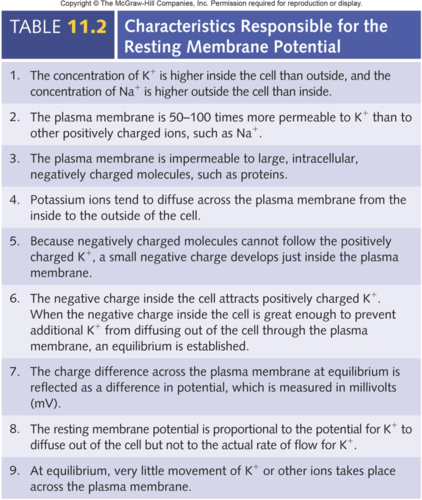
81
New cards
How K+ concentration gradient depolarizes the RMP
If extracellular concentration of K+ increases, not as much K+ will want to go out, down it's concentration gradient. So, a less negative charge is needed inside the cell.

82
New cards
How K+ concentration gradient hyperpolarizes the RMP
If extracellular ion concentration decreases: steeper gradient (difference) between inside and outside.
83
New cards
Which of these terms are correctly matched?
A. depolarization: membrane potential becomes more negative.
B. hyperpolarization: membrane potential becomes more negative.
C. hyperpolarization: membrane potential becomes more positive.
A. depolarization: membrane potential becomes more negative.
B. hyperpolarization: membrane potential becomes more negative.
C. hyperpolarization: membrane potential becomes more positive.
B. hyperpolarization: membrane potential becomes more negative.
84
New cards
Changes in Resting Membrane Potential: Na+
1. Changes to the concentration of Na+ inside or outside the cell has very little effect (gates closed).
2. If gates open (like when ACh attaches to ligand receptors), Na+ diffuses into the cell, which results in depolarization of the membrane.
2. If gates open (like when ACh attaches to ligand receptors), Na+ diffuses into the cell, which results in depolarization of the membrane.
85
New cards
Changes in Resting Membrane Potential: Ca2+
1. Voltage-gated Na+ channels are sensitive to changes in extracellular Ca2+ concentrations, so if the extracellular Ca2+ concentration decreases, Na+ gates open, which results in depolarization.
2. If the extracellular concentration of Ca2+ increases, Na+ gates close and membrane repolarizes. (hyperpolarization).
2. If the extracellular concentration of Ca2+ increases, Na+ gates close and membrane repolarizes. (hyperpolarization).
86
New cards
Hypocalcemia
Uncontrolled contraction of skeletal muscles - tetany because of increased membrane permeability to Na+
87
New cards
Graded potential/Local Potential
A small change in the RMP confined to a small area of the plasma membrane
88
New cards
How are graded potentials and action potentials different?
An action potential spreads over the entire surface of the cell
89
New cards
Graded potentials result from (5 things)
1. Ligands binding
2. Changes in voltage
3. Mechanical stimulation
4. Temperature changes
5. Spontaneous change in permeability
2. Changes in voltage
3. Mechanical stimulation
4. Temperature changes
5. Spontaneous change in permeability
90
New cards
Summation
when graded potentials add onto each other
91
New cards
Graded potentials can spread (conduct) over part of plasma membrane, but:
they rapidly decrease in magnitude
92
New cards
Characteristics of graded potentials (5 things)

93
New cards
Graded (or Local) potentials
A. Always cause an action potential.
B. Never summate.
C. Can travel long distances.
D. Are confined to a small region of the plasma membrane.
A. Always cause an action potential.
B. Never summate.
C. Can travel long distances.
D. Are confined to a small region of the plasma membrane.
D. Are confined to a small region of the plasma membrane.
94
New cards
Action potential graph
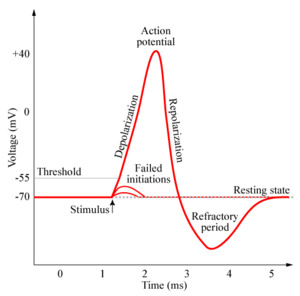
95
New cards
6 characteristics of action potentials
1. Action potentials are produced when a graded potential reaches threshold
2. Actions potentials are all-or-none
3. Depolarization is a result of increased membrane permeability to Na+ and movement of Na+ into the cell. Activation gates of the voltage-gated Na+ channels open
4. Repolarization is a result of decreased membrane permeability to Na+ and increased membrane permeability to K+, which stops Na+ movement into the cell and increases K+ movement out of the cell. The inactivation gates of the voltage-gated Na+ channels close, and the voltage-gated K+ channels open.
5. Action potentials are propagated and, for a given axon or muscle fiber, the magnitude of the action potential is constant.
6. Stimulus strength determines the frequency of action potentials.
2. Actions potentials are all-or-none
3. Depolarization is a result of increased membrane permeability to Na+ and movement of Na+ into the cell. Activation gates of the voltage-gated Na+ channels open
4. Repolarization is a result of decreased membrane permeability to Na+ and increased membrane permeability to K+, which stops Na+ movement into the cell and increases K+ movement out of the cell. The inactivation gates of the voltage-gated Na+ channels close, and the voltage-gated K+ channels open.
5. Action potentials are propagated and, for a given axon or muscle fiber, the magnitude of the action potential is constant.
6. Stimulus strength determines the frequency of action potentials.
96
New cards
Absolute refractory period
from the beginning of the action potential to the near end of repolarization - no matter how large a stimulus, there can be no second action potential
97
New cards
Relative refractory period
A stronger-than-threshold stimulus can initiate another action potential
98
New cards
Action potential frequency
Number of action potentials produced per unit of time to a stimulus

99
New cards
Supramaximal stimulus
any stimulus stronger than a maximal stimulus - these stimuli cannot produce a greater frequency of action potentials than a maximal stimulus
100
New cards
Action potential propagation
an action potential at one site causes an action potential at the next location by stimulating voltage gated Na+ channels in adjacent regions of the membrane
